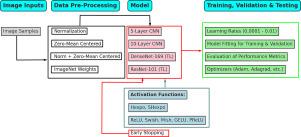Shifted Hexpo activation function: An improved vanishing gradient mitigation activation function for disease classification
IF 4.9
引用次数: 0
Abstract
Activation functions (AFs) in deep learning significantly impacts model performance. In this study, we proposed Shifted Hexpo (SHexpo), an improved variant of the Hexpo AF, designed to address limitations such as vanishing gradients and parameter sensitivity. SHexpo introduces a shifting parameter, enhancing its adaptability and performance across diverse data distributions. Using ResNet 101, DenseNet 169, 5 and 10-layer lightweight Convolutional Neural Network (CNN) trained on the SIPaKMeD dataset for cervical cancer classification, we compared SHexpo against Hexpo, ReLU, Swish, Mish, GELU and PReLU under four pre-processing techniques: zero-mean centering, normalization, their combination and ImageNet weights. Our results demonstrate that SHexpo achieves higher classification accuracy and better gradient stability than Hexpo while performing competitively with state-of-the-art AFs. Our findings indicate that SHexpo can be effectively integrated into both lightweight and deep architectures. Additionally, Grad-CAM visualizations highlight SHexpo’s capability to enhance interpretability by localizing the most relevant image regions contributing to model predictions. These results demonstrate SHexpo’s potentials for medical image analysis in low-resource settings.

移位的Hexpo激活函数:一种用于疾病分类的改进的消失梯度缓解激活函数
深度学习中的激活函数(AFs)对模型性能有显著影响。在这项研究中,我们提出了移位Hexpo (SHexpo),这是Hexpo AF的改进版本,旨在解决梯度消失和参数灵敏度等限制。SHexpo引入了一个移位参数,增强了它在不同数据分布中的适应性和性能。利用在SIPaKMeD数据集上训练的ResNet 101、DenseNet 169、5层和10层轻量级卷积神经网络(CNN)进行宫颈癌分类,比较了SHexpo与Hexpo、ReLU、Swish、Mish、GELU和PReLU四种预处理技术:零均值定心、归一化、它们的组合和ImageNet权值。我们的研究结果表明,SHexpo比Hexpo具有更高的分类精度和更好的梯度稳定性,同时与最先进的AFs具有竞争力。我们的发现表明SHexpo可以有效地集成到轻量级和深度架构中。此外,Grad-CAM可视化突出了SHexpo通过定位最相关的图像区域来促进模型预测的可解释性的能力。这些结果证明了SHexpo在低资源环境下医学图像分析的潜力。
本文章由计算机程序翻译,如有差异,请以英文原文为准。
求助全文
约1分钟内获得全文
求助全文
来源期刊

Machine learning with applications
Management Science and Operations Research, Artificial Intelligence, Computer Science Applications
自引率
0.00%
发文量
0
审稿时长
98 days
 求助内容:
求助内容: 应助结果提醒方式:
应助结果提醒方式:


